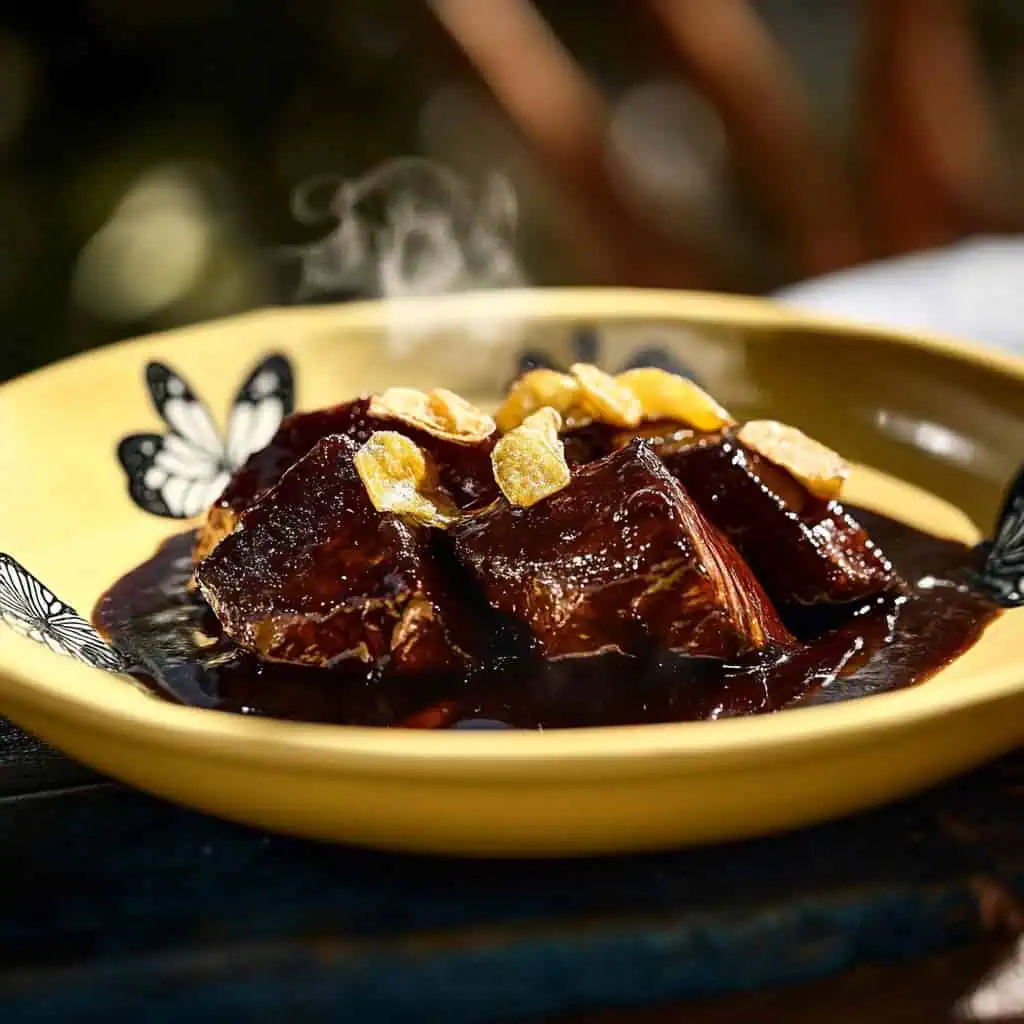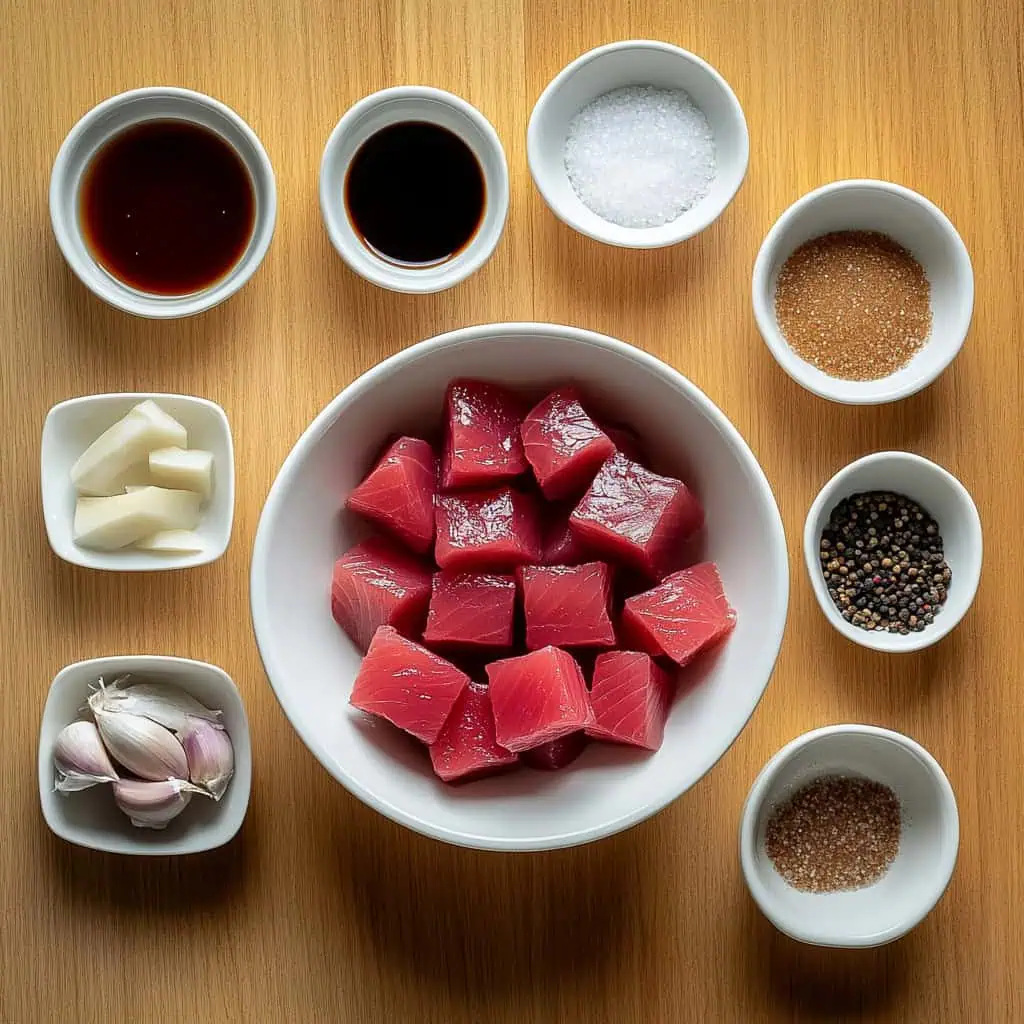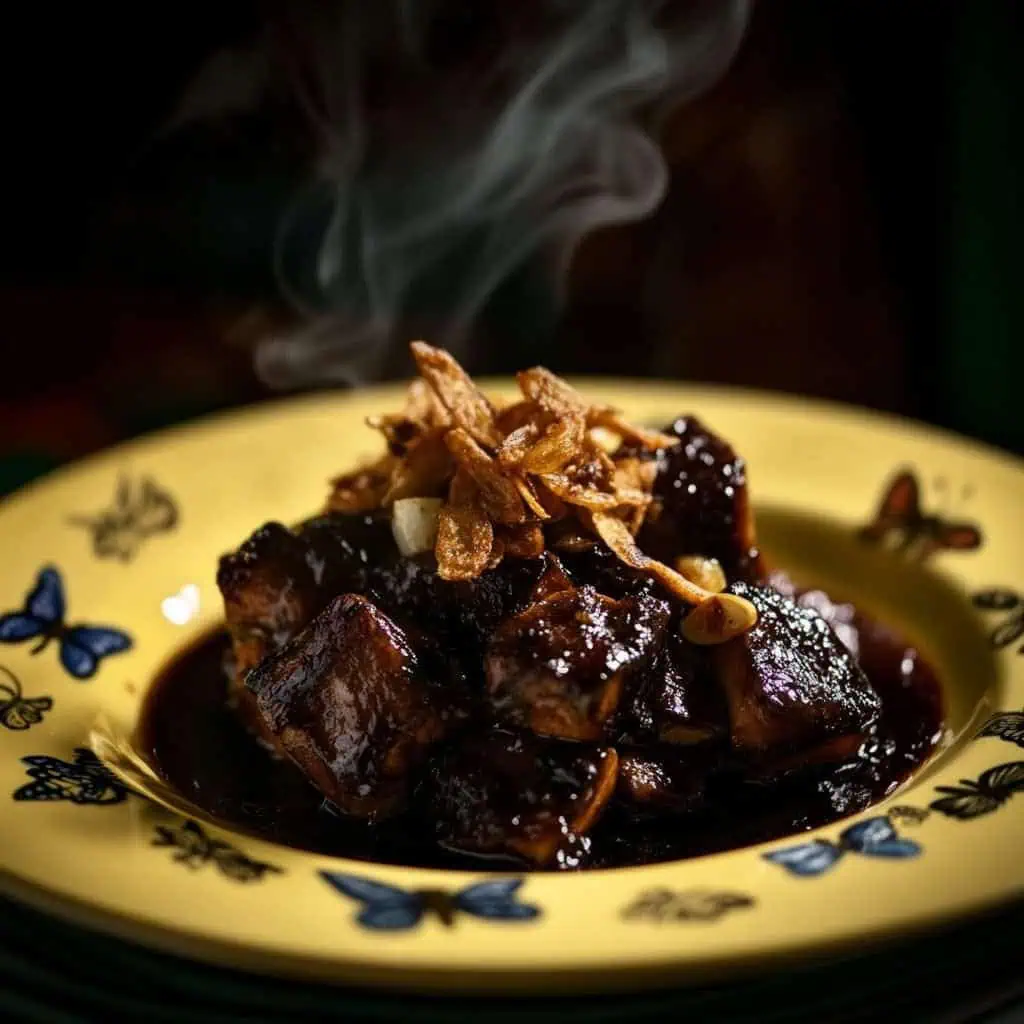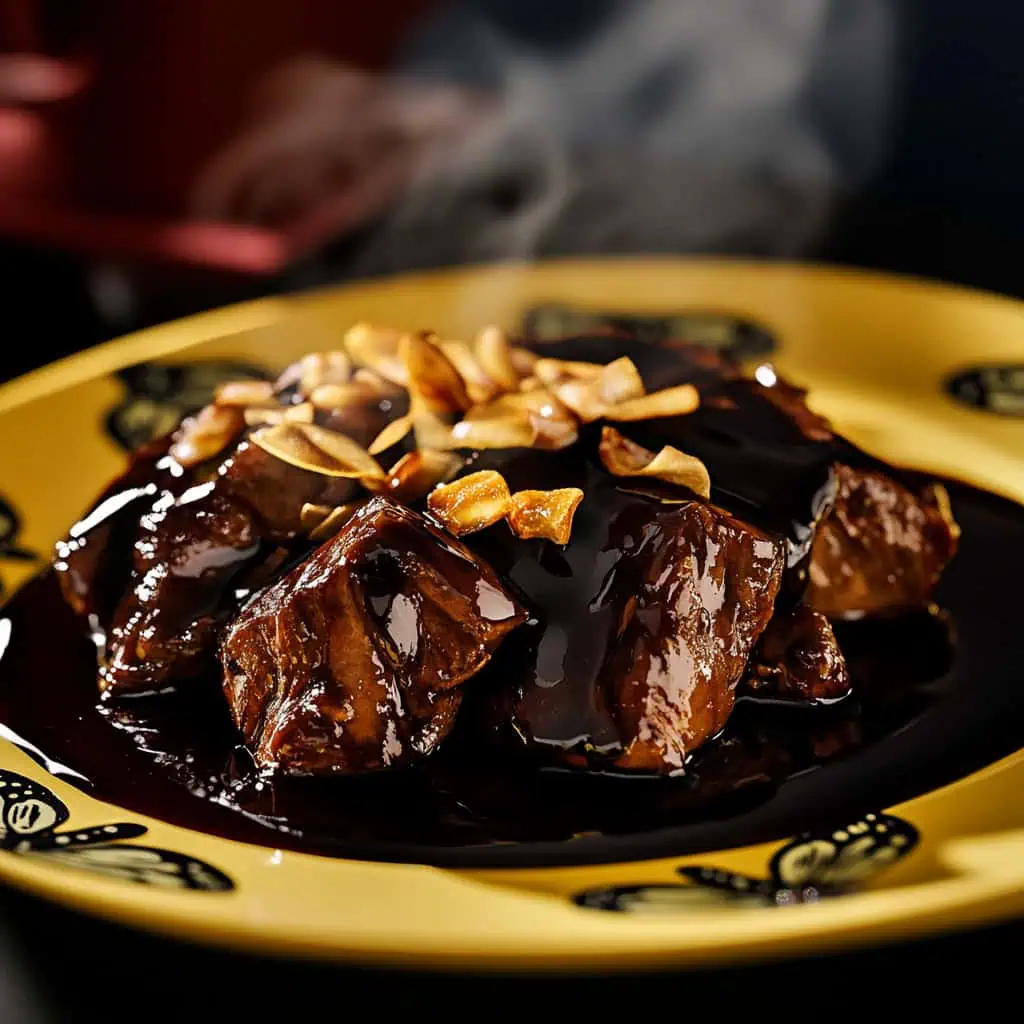You know how we Filipinos just can't resist a good adobo? I grew up with the classic pork and chicken versions, but lately I've been trying to eat healthier without giving up my favorite comfort food. That's when I discovered this Adobong Tuna recipe.
It's my healthy take on our beloved dish, using fresh sashimi-grade tuna instead of the usual meat. It still has that rich, garlicky, soy-vinegar goodness we all love, but it's lighter and packed with protein. Plus, it cooks in half the time of traditional adobo.
I first made this when I was craving adobo but wanted something that wouldn't make me feel guilty about having seconds. Now it's become a regular in my kitchen, especially on days when I want something quick but still craving those classic Filipino flavors. If you love adobo as much as I do but want a healthier spin, you're in for a treat!
Jump to:

Why You'll Love This Recipe
- Quick and Healthy: Ready in just 30 minutes with lean protein
- Restaurant Quality: Uses sashimi-grade tuna for premium results
- Versatile: Perfect for both everyday meals and special occasions
- Balanced Flavors: Classic adobo taste with a seafood twist
- Budget-Friendly Luxury: More affordable than traditional meat cuts
Ingredients
This recipe balances premium sashimi-grade tuna with the classic Filipino adobo sauce components. The high-quality tuna provides a tender texture and rich flavor that absorbs the perfect balance of salty soy sauce, tangy vinegar, and mild sweetness from brown sugar.
Fresh garlic adds essential aromatic depth, while the neutral canola oil allows for high-heat searing without interfering with the delicate flavors. Each ingredient plays a crucial role in creating that unmistakable adobo taste while complementing the natural qualities of the fish.

For the Tuna:
- 500g sashimi-grade tuna, cut into ½-inch cubes
- Salt, to taste
- Ground black pepper, to taste
- 4 tablespoons canola oil
For the Sauce:
- 3 cloves garlic, peeled and thinly sliced
- ⅓ cup soy sauce
- ⅓ cup vinegar (white or cane vinegar preferred)
- 1 tablespoon brown sugar
Equipment
- Heavy-Bottom Skillet or Wok: Essential for even heat distribution and perfect searing of the tuna
- Sharp Chef's Knife: Ensures clean cuts of tuna without tearing the delicate flesh
- Measuring Cups and Spoons: For accurate ingredient portions, crucial for the perfect balance of flavors
- Wooden Spatula: Allows gentle handling of tuna pieces to prevent them from breaking
- Cutting Board: Preferably with juice groove for clean preparation of the fish
- Paper Towels: For patting the tuna dry before searing
- Small Bowl: For mixing sauce ingredients

How To Make
- Pat the tuna dry with paper towels then cut it into ½-inch cubes. Season the cubes with salt and black pepper, then set aside.
- Heat 4 tablespoons of canola oil in a skillet over high heat until shimmering. Carefully add the tuna cubes and sear them quickly for about 30 seconds on each side until they have a light brown color. Be careful not to overcook. Remove the tuna from the pan and set aside.
- Using the same pan with the remaining oil, lower the heat to medium and add the thinly sliced garlic. Cook until the garlic turns golden brown and crispy, about 1-2 minutes.
- Pour in ⅓ cup soy sauce and ⅓ cup vinegar. Add 1 tablespoon brown sugar and stir until dissolved. Let the sauce simmer and reduce for about 3-5 minutes until it starts to thicken slightly.
- Return the seared tuna cubes to the pan. Gently toss the tuna in the sauce just until heated through, about 30 seconds. Don't stir too much or the tuna will break apart.
- Transfer to a serving dish immediately. Serve hot with steamed rice. For best results, the tuna should still be slightly pink in the center.

Tips from Lola's Kitchen
- Select the Perfect Tuna: Look for pieces that are bright red, firm to the touch, and have a clean ocean smell
- Temperature Matters: Keep the tuna refrigerated until the very last minute before preparation
- Proper Searing Technique: Make sure your pan is very hot before adding the tuna, and don't overcrowd the pan
- The Cutting Trick: For easier cutting, place the tuna in the freezer for 15 minutes first to firm it up slightly
- Oil Selection: Use a neutral oil with a high smoke point for the best searing results
- Garlic Preparation: Slice the garlic thinly rather than mincing for better texture and more even cooking
- Protect the Texture: Be extremely gentle when returning the tuna to the sauce—over-stirring will break the delicate cubes
Substitutions
- Tuna: Salmon or swordfish make excellent alternatives with similar cooking properties
- Canola Oil: Substitute with coconut oil for a subtle tropical note or any neutral vegetable oil
- Brown Sugar: White sugar or honey work well, adjust quantity to taste
- Fresh Garlic: If unavailable, use 1.5 teaspoons garlic powder (though fresh is strongly preferred)
- White Vinegar: Apple cider vinegar or cane vinegar (sukang maasim) offer different but complementary flavor profiles
- Soy Sauce: Tamari or coconut aminos for gluten-free options
Troubleshooting
Tough, Chewy Tuna
- Problem: Tuna has become tough and rubbery
- Solution: You've likely overcooked it. Remember that tuna should be just seared on the outside and remain slightly pink in the center. Next time, reduce the cooking time and make sure your pan is hot enough for a quick sear.
Watery Sauce
- Problem: The adobo sauce is too thin and not coating the tuna properly
- Solution: Simmer the sauce longer before adding the tuna back. If already at this stage, remove the tuna and reduce the sauce further, then gently reintroduce the fish.
Too Sour
- Problem: The vinegar flavor is overwhelming
- Solution: Add ½ tablespoon more brown sugar and a small pinch of salt to balance the acidity. In future preparations, you can reduce the vinegar slightly or increase the sugar.
Falling Apart Tuna
- Problem: The tuna cubes are breaking apart in the sauce
- Solution: Handle the tuna even more gently and reduce the time it spends in the sauce. Also check that you're using sashimi-grade tuna, which holds together better.
Bland Flavor
- Problem: The dish lacks the depth of traditional adobo
- Solution: Let the sauce reduce more to concentrate flavors, and consider adding a bay leaf during the simmering process.
Storage & Reheating
Refrigerator Storage:
- Store in an airtight container for up to 2 days.
- Keep the sauce separate from any leftover tuna if possible to preserve the fish's texture.
Freezing:
- Not recommended for this dish as freezing will significantly alter the texture of the seared tuna.
Reheating:
- Use gentle heat in a pan until just warm to preserve texture.
- Ideally, consume leftovers cold or at room temperature as a salad topping to maintain the tuna's quality.
- If you must reheat, do so briefly in a covered pan with a splash of water to create steam.

FAQ
Can I use frozen tuna steaks for this recipe?
Yes, but ensure they're completely thawed and patted dry before cooking. While fresh is always preferable, good quality frozen tuna can still deliver excellent results.
Why specifically sashimi-grade tuna?
Sashimi-grade tuna ensures the best quality, texture, and safety, especially important since we're cooking the tuna very briefly. The higher fat content also contributes to a better final dish.
Can I make this dish in advance for a dinner party?
This dish is best enjoyed immediately after cooking. If necessary, you can prepare the sauce in advance and cook the tuna just before serving. For best results, serve within 2-3 hours of preparation.
Is this recipe keto-friendly?
Yes, with a simple modification. Replace the brown sugar with a keto-friendly sweetener, and this dish fits perfectly into a ketogenic meal plan.
How can I reduce the sodium content?
Use low-sodium soy sauce and reduce the quantity by about 25%, adding a splash of water to maintain the liquid ratio. You can also increase the black pepper slightly to compensate for flavor.
What's the best vinegar to use for authentic flavor?
Traditional Filipino cane vinegar (sukang maasim) offers the most authentic flavor profile, but white vinegar or rice vinegar work well as widely available alternatives.
Is this dish child-friendly?
Most children enjoy the mild, sweet-savory profile of this dish, especially when served over rice. For pickier eaters, consider cutting the tuna into smaller pieces and reducing the vinegar slightly.
What wine pairs well with Tuna Adobo?
A light-bodied Pinot Noir or a crisp Sauvignon Blanc complements the umami flavors of this dish beautifully.
Related
Looking for other recipes like this? Try these:

Adobong Tuna (Filipino Tuna Adobo)
Equipment
- Heavy-Bottom Skillet (kawali) For even heat distribution and perfect searing
- Sharp knife (matulis na kutsilyo) For clean cuts of tuna
- Measuring cups and spoons (Panukat) For accurate ingredient portions
- Wooden spatula (sandok na kahoy) For gentle handling of tuna pieces
- Cutting board (Sangkalan) Preferably with juice groove for clean preparation
Ingredients
For the Tuna
- 500 g sashimi-grade tuna Sariwang tuna/tambakol, cut into ½-inch cubes
- Salt Asin, to taste
- Ground black pepper Dinurog na paminta, to taste
- 4 tablespoons canola oil Mantika
For the Sauce
- 3 cloves garlic Bawang, peeled and thinly sliced
- ⅓ cup soy sauce Toyo
- ⅓ cup vinegar Suka
- 1 tablespoon brown sugar Asukal na Pula
Instructions
- First, pat the tuna dry with paper towels then cut it into ½-inch cubes. Season the cubes with salt and black pepper, then set aside.
- Heat 4 tablespoons of canola oil in a skillet over high heat until shimmering. Carefully add the tuna cubes and sear them quickly for about 30 seconds on each side until they have a light brown color. Be careful not to overcook. Remove the tuna from the pan and set aside.
- Using the same pan with the remaining oil, lower the heat to medium and add the thinly sliced garlic. Cook until the garlic turns golden brown and crispy, about 1-2 minutes.
- Pour in ⅓ cup soy sauce and ⅓ cup vinegar. Add 1 tablespoon brown sugar and stir until dissolved. Let the sauce simmer and reduce for about 3-5 minutes until it starts to thicken slightly.
- Return the seared tuna cubes to the pan. Gently toss the tuna in the sauce just until heated through, about 30 seconds. Don't stir too much or the tuna will break apart.
- Transfer to a serving dish immediately. Serve hot with steamed rice. For best results, the tuna should still be slightly pink in the center.
Tips from Lola's Kitchen
- Choose tuna that's bright red and firm to touch
- Ask your fishmonger for "sashimi-grade" or "grade 1" tuna
- Keep the tuna cold until ready to cook
- Don't overcrowd the pan when searing
- For best results, slice tuna while it's still slightly frozen
Nutrition
The Story Behind Adobong Tuna
Adobo, the undisputed national dish of the Philippines, has countless variations across our 7,641 islands. While most Filipinos know adobo as a dish of pork or chicken braised in vinegar, soy sauce, and garlic, our coastal communities have long been creating their own seafood versions of this beloved comfort food. This Tuna Adobo recipe is a perfect example of how our cooking traditions adapt to both regional ingredients and modern healthy eating habits.
In coastal areas like General Santos City, known as the Tuna Capital of the Philippines, locals have been cooking fresh tuna in adobo style for generations. The abundance of yellowfin tuna in the waters of the Mindanao Sea naturally led to creative ways of preparing this premium fish. While traditional meat adobo requires long cooking times to tenderize the protein, tuna adobo showcases how the same beloved sauce can transform a quick-cooking protein into something equally spectacular.
What makes this version special is its use of sashimi-grade tuna, a modern twist that speaks to both our contemporary access to premium ingredients and our growing awareness of health-conscious cooking. The quick cooking time preserves the tuna's natural omega-3 fatty acids while the vinegar and soy sauce perfectly complement its rich flavor. This isn't just an adaptation of adobo; it's an evolution that honors our culinary heritage while embracing healthier cooking methods.
The beauty of this dish lies in how it bridges tradition and innovation. The sauce still carries the soul-warming flavors that define Filipino adobo – the perfect balance of sour, salty, and garlicky notes that we've all grown up with. Yet, the use of premium tuna elevates it to a dish worthy of special occasions while being simple enough for everyday meals. It's a testament to how Filipino cuisine continues to evolve while staying true to its roots, proving that healthy eating doesn't mean sacrificing the flavors we love.
Whether you're a health-conscious food lover, a Filipino food enthusiast, or simply someone looking to expand their adobo repertoire, this tuna version offers a delicious glimpse into the versatility of Filipino cooking. It's where tradition meets wellness, where coastal flavors meet our national dish, and where simple ingredients transform into something extraordinary.










Comments
No Comments